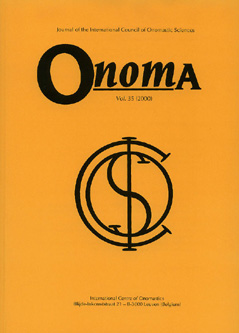 previous article in this issue previous article in this issue | next article in this issue  |

Preview first page |
Document Details : Title: Teaching Toponymy at University Level Subtitle: Geographical Names, Maps and GIS Author(s): KADMON, Naftali Journal: Onoma Volume: 39 Date: 2004 Pages: 275-287 DOI: 10.2143/ONO.39.0.2020717 Abstract : This paper describes an annual course in toponymy at the Hebrew University of Jerusalem, Israel. The paragraph headings are as follows: (1) Introduction, (2) Who needs a course in toponymy? (3) Geographical and linguistic contents, (4) Recording, storing and transmission of geographical names, (5) Changes through space and time, (6) Semantics do all toponyms have meaning? (7) Geographical names as a cultural phenomenon, (8) Transformation and standardization of toponyms, (9) Names in maps and in a GIS. Of two appendices, the first describes the course syllabus, while second is a list of contents of the textbook. Cet article décrit un cours de toponymie donné annuellement à l’Université Hébraïque de Jérusalem, Israël, composé de neuf parties : 1) Introduction. 2) Qui a besoin d’un cours de toponymie ? 3) Contenu géographique et linguistique. 4) Enregistrement, conservation et diffusion des noms géographiques. 5) Changements dans l’espace et le temps. 6) Aspects sémantiques : tous les toponymes ont-ils un sens ? 7) Les noms géographiques comme phénomènes culturels. 8) Transformation et normalisation des toponymes. 9) Les noms géographiques sur les cartes et dans les SIG. Un appendice donne le syllabus du cours et un second, la table des matières du manuel. Vorliegender Artikel beschreibt einen jährlich stattfindenden Toponymie-Kurs an der Hebräischen Universität Jerusalem, Israel. Die Überschriften der Abschnitte lauten: 1) Einführung, 2) Wer braucht einen Toponymie-Kurs?, 3) Geographischer und sprachlicher Inhalt, 4) Aufnahme, Lagerung und Übertragung von geographischen Namen, 5) Veränderungen durch Zeit und Raum, 6) Semantik – haben alle Toponyme eine Bedeutung?, 7) Geographische Namen als kulturelle Erscheinung, 8) Transformation und Standardisierung von Toponymen, 9) Namen auf Karten und GIS, 10) Der Dozent. Von den beiden Anhängen beschreibt der erste den Kurs-Inhalt (Syllabus), während der zweite eine Inhaltsliste des Lehrbuches enthält. |
|


